Wesfarmers Financial Analysis
VerifiedAdded on 2020/04/07
|17
|4166
|64
AI Summary
This assignment requires a comprehensive analysis of Wesfarmers' financial performance based on their annual reports for 2012, 2016, and 2017. Students need to apply accounting principles to evaluate key financial metrics such as profitability, liquidity, leverage, and investment strategies. The analysis should draw insights from the company's operations, industry trends, and external economic factors. Additionally, students are expected to demonstrate an understanding of relevant accounting standards and their impact on financial reporting.
Contribute Materials
Your contribution can guide someone’s learning journey. Share your
documents today.
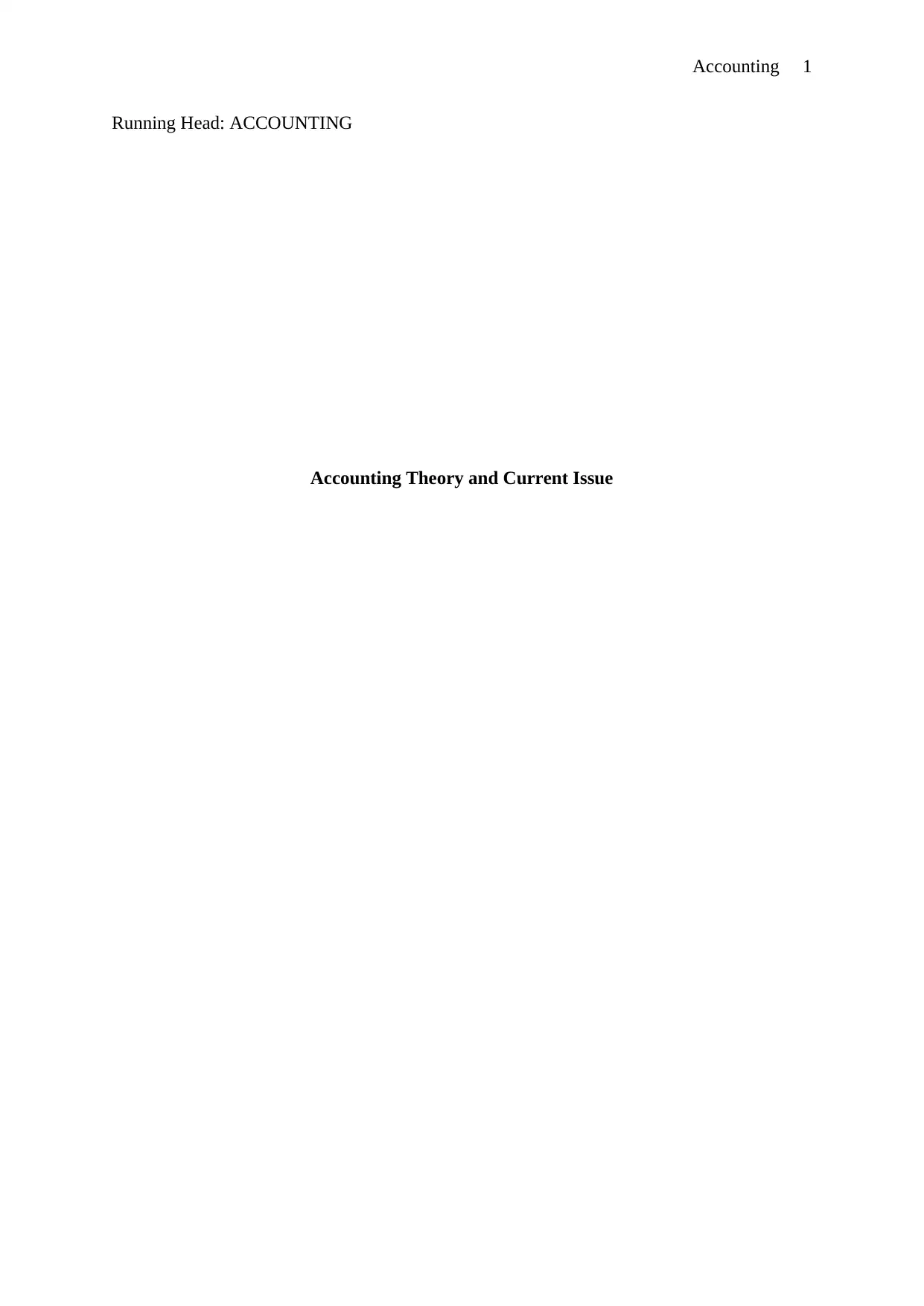
Accounting 1
Running Head: ACCOUNTING
Accounting Theory and Current Issue
Running Head: ACCOUNTING
Accounting Theory and Current Issue
Secure Best Marks with AI Grader
Need help grading? Try our AI Grader for instant feedback on your assignments.
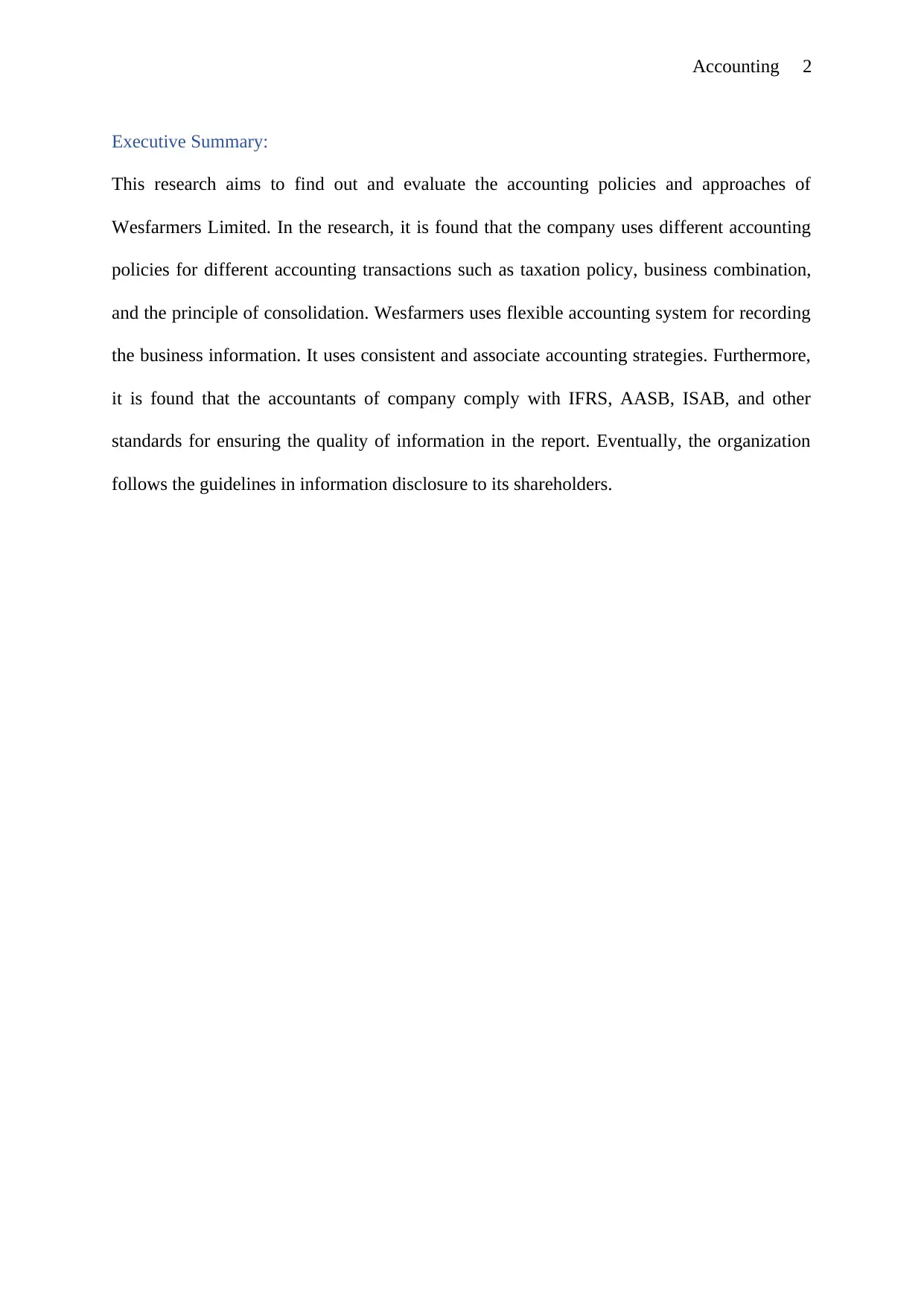
Accounting 2
Executive Summary:
This research aims to find out and evaluate the accounting policies and approaches of
Wesfarmers Limited. In the research, it is found that the company uses different accounting
policies for different accounting transactions such as taxation policy, business combination,
and the principle of consolidation. Wesfarmers uses flexible accounting system for recording
the business information. It uses consistent and associate accounting strategies. Furthermore,
it is found that the accountants of company comply with IFRS, AASB, ISAB, and other
standards for ensuring the quality of information in the report. Eventually, the organization
follows the guidelines in information disclosure to its shareholders.
Executive Summary:
This research aims to find out and evaluate the accounting policies and approaches of
Wesfarmers Limited. In the research, it is found that the company uses different accounting
policies for different accounting transactions such as taxation policy, business combination,
and the principle of consolidation. Wesfarmers uses flexible accounting system for recording
the business information. It uses consistent and associate accounting strategies. Furthermore,
it is found that the accountants of company comply with IFRS, AASB, ISAB, and other
standards for ensuring the quality of information in the report. Eventually, the organization
follows the guidelines in information disclosure to its shareholders.
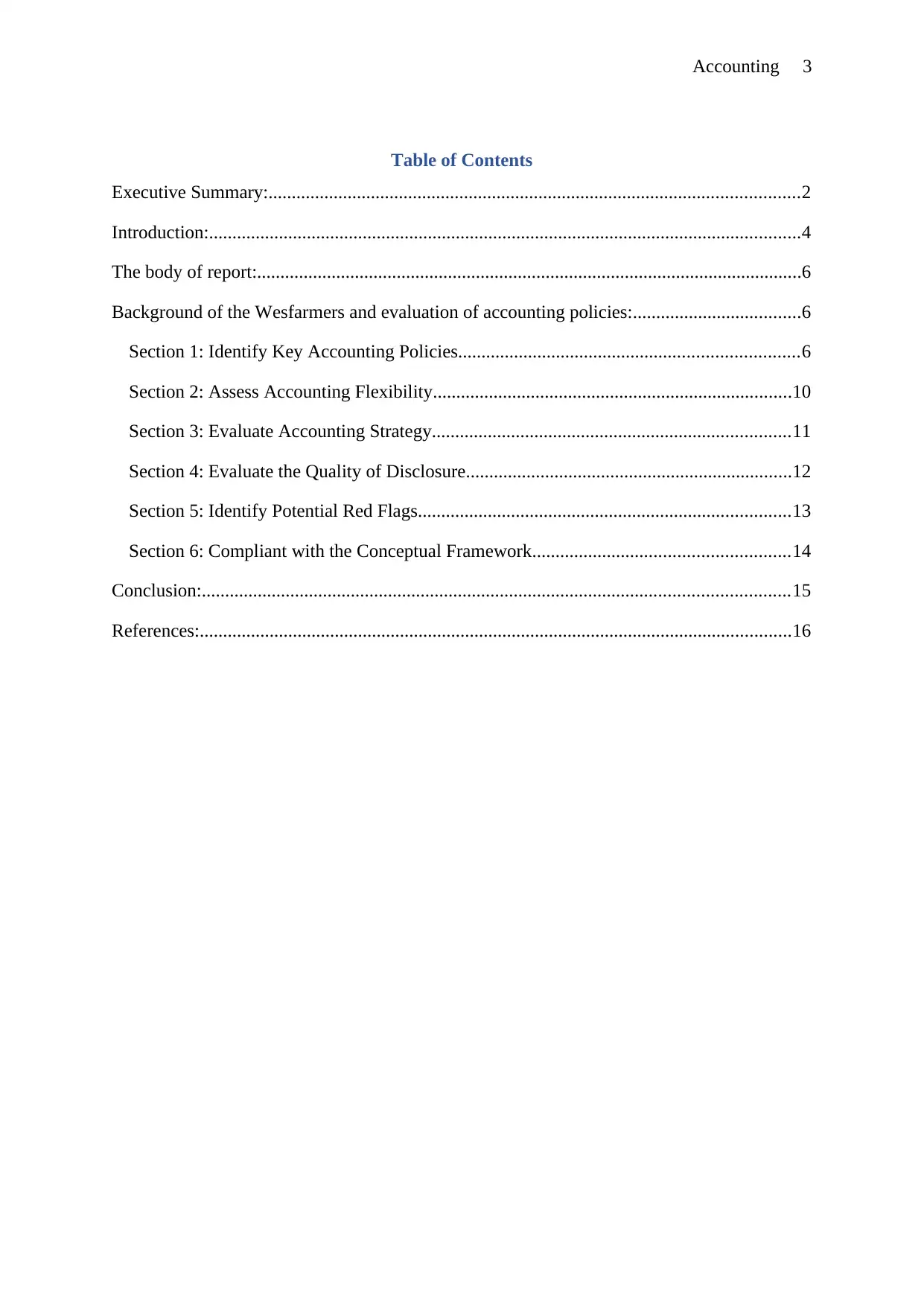
Accounting 3
Table of Contents
Executive Summary:..................................................................................................................2
Introduction:...............................................................................................................................4
The body of report:.....................................................................................................................6
Background of the Wesfarmers and evaluation of accounting policies:....................................6
Section 1: Identify Key Accounting Policies.........................................................................6
Section 2: Assess Accounting Flexibility.............................................................................10
Section 3: Evaluate Accounting Strategy.............................................................................11
Section 4: Evaluate the Quality of Disclosure......................................................................12
Section 5: Identify Potential Red Flags................................................................................13
Section 6: Compliant with the Conceptual Framework.......................................................14
Conclusion:..............................................................................................................................15
References:...............................................................................................................................16
Table of Contents
Executive Summary:..................................................................................................................2
Introduction:...............................................................................................................................4
The body of report:.....................................................................................................................6
Background of the Wesfarmers and evaluation of accounting policies:....................................6
Section 1: Identify Key Accounting Policies.........................................................................6
Section 2: Assess Accounting Flexibility.............................................................................10
Section 3: Evaluate Accounting Strategy.............................................................................11
Section 4: Evaluate the Quality of Disclosure......................................................................12
Section 5: Identify Potential Red Flags................................................................................13
Section 6: Compliant with the Conceptual Framework.......................................................14
Conclusion:..............................................................................................................................15
References:...............................................................................................................................16
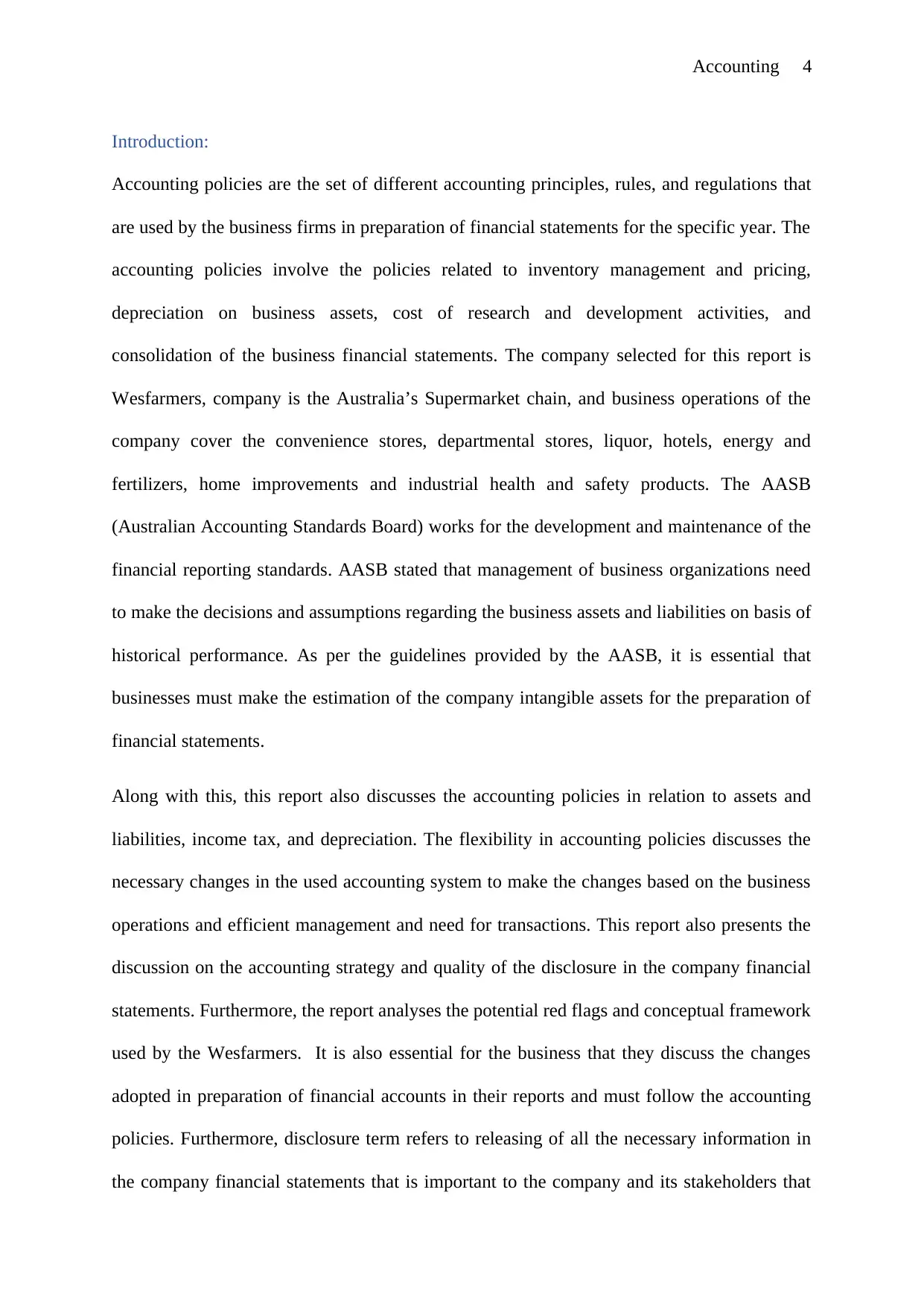
Accounting 4
Introduction:
Accounting policies are the set of different accounting principles, rules, and regulations that
are used by the business firms in preparation of financial statements for the specific year. The
accounting policies involve the policies related to inventory management and pricing,
depreciation on business assets, cost of research and development activities, and
consolidation of the business financial statements. The company selected for this report is
Wesfarmers, company is the Australia’s Supermarket chain, and business operations of the
company cover the convenience stores, departmental stores, liquor, hotels, energy and
fertilizers, home improvements and industrial health and safety products. The AASB
(Australian Accounting Standards Board) works for the development and maintenance of the
financial reporting standards. AASB stated that management of business organizations need
to make the decisions and assumptions regarding the business assets and liabilities on basis of
historical performance. As per the guidelines provided by the AASB, it is essential that
businesses must make the estimation of the company intangible assets for the preparation of
financial statements.
Along with this, this report also discusses the accounting policies in relation to assets and
liabilities, income tax, and depreciation. The flexibility in accounting policies discusses the
necessary changes in the used accounting system to make the changes based on the business
operations and efficient management and need for transactions. This report also presents the
discussion on the accounting strategy and quality of the disclosure in the company financial
statements. Furthermore, the report analyses the potential red flags and conceptual framework
used by the Wesfarmers. It is also essential for the business that they discuss the changes
adopted in preparation of financial accounts in their reports and must follow the accounting
policies. Furthermore, disclosure term refers to releasing of all the necessary information in
the company financial statements that is important to the company and its stakeholders that
Introduction:
Accounting policies are the set of different accounting principles, rules, and regulations that
are used by the business firms in preparation of financial statements for the specific year. The
accounting policies involve the policies related to inventory management and pricing,
depreciation on business assets, cost of research and development activities, and
consolidation of the business financial statements. The company selected for this report is
Wesfarmers, company is the Australia’s Supermarket chain, and business operations of the
company cover the convenience stores, departmental stores, liquor, hotels, energy and
fertilizers, home improvements and industrial health and safety products. The AASB
(Australian Accounting Standards Board) works for the development and maintenance of the
financial reporting standards. AASB stated that management of business organizations need
to make the decisions and assumptions regarding the business assets and liabilities on basis of
historical performance. As per the guidelines provided by the AASB, it is essential that
businesses must make the estimation of the company intangible assets for the preparation of
financial statements.
Along with this, this report also discusses the accounting policies in relation to assets and
liabilities, income tax, and depreciation. The flexibility in accounting policies discusses the
necessary changes in the used accounting system to make the changes based on the business
operations and efficient management and need for transactions. This report also presents the
discussion on the accounting strategy and quality of the disclosure in the company financial
statements. Furthermore, the report analyses the potential red flags and conceptual framework
used by the Wesfarmers. It is also essential for the business that they discuss the changes
adopted in preparation of financial accounts in their reports and must follow the accounting
policies. Furthermore, disclosure term refers to releasing of all the necessary information in
the company financial statements that is important to the company and its stakeholders that
Secure Best Marks with AI Grader
Need help grading? Try our AI Grader for instant feedback on your assignments.
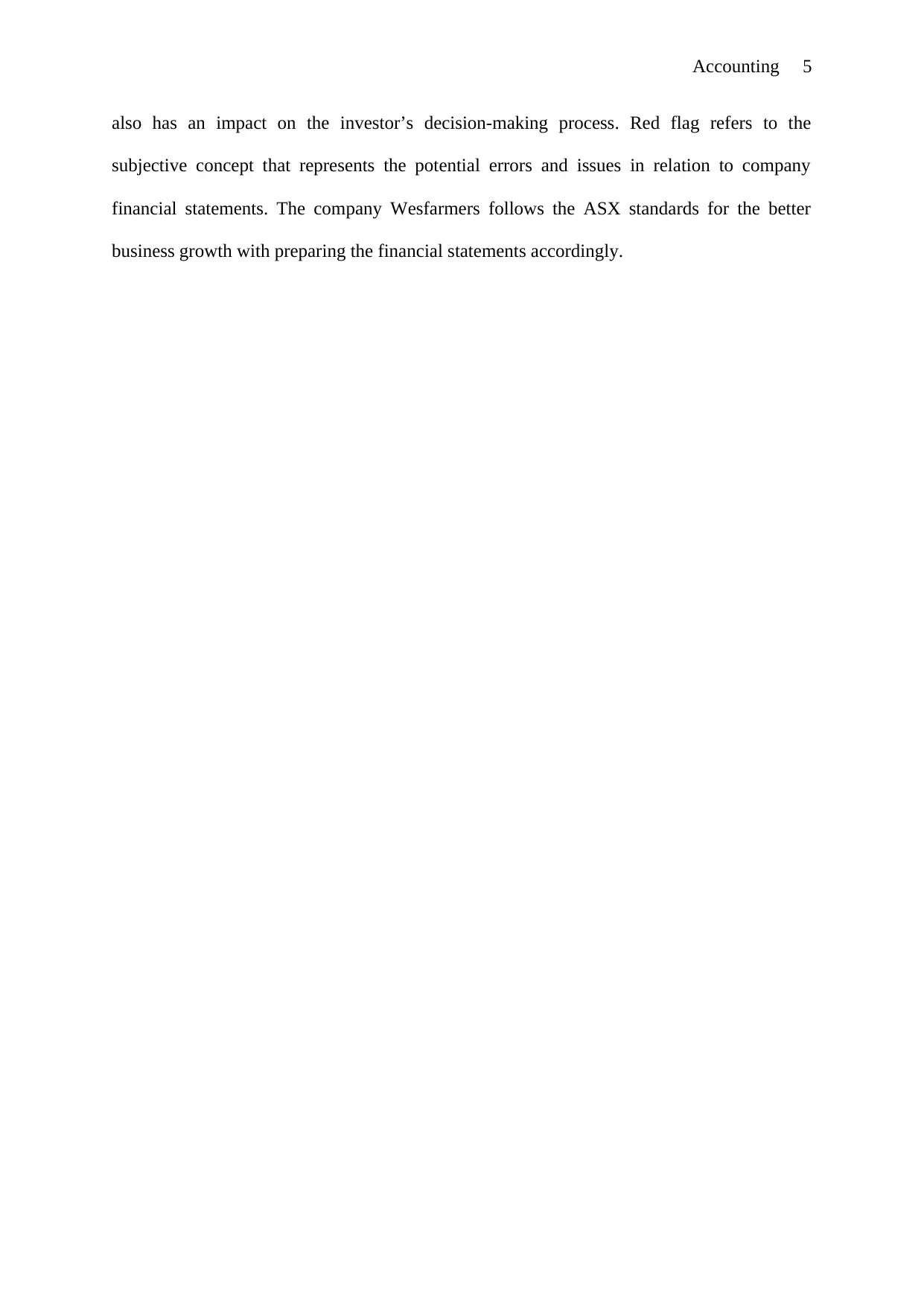
Accounting 5
also has an impact on the investor’s decision-making process. Red flag refers to the
subjective concept that represents the potential errors and issues in relation to company
financial statements. The company Wesfarmers follows the ASX standards for the better
business growth with preparing the financial statements accordingly.
also has an impact on the investor’s decision-making process. Red flag refers to the
subjective concept that represents the potential errors and issues in relation to company
financial statements. The company Wesfarmers follows the ASX standards for the better
business growth with preparing the financial statements accordingly.

Accounting 6
The body of report:
Background of the Wesfarmers and evaluation of accounting policies:
Wesfarmers is a leading Australian company that was founded in the year 1914 as Western
Australian farmers. The company is the Australia’s largest listed company and headquarters
of the company is situated in the Western Australia. The company operates their business
across the United Kingdom, Australia, Ireland, and New Zealand. The business operations of
the company include the supermarkets, convenience and departmental stores, a division of
chemicals, hotels, liquor, and fertilizers. The company is also listed on the Australian
Securities Exchange from the year 1984 with the name WES. Along with this, the company
operates their business with more than 222,000 employees and 530,000 (in the year 2016)
shareholders worldwide that make the company as Australia’s largest employer (Wesfarmers,
2016). The company also focused on the research and development activities to improve the
level of services and development of new products for the client’s satisfaction. The financial
statements of the company in the year 2016 and 2017 involve the controlled entities and
economic entities. The involved different components in Westerners Annual report are as
below:
Section 1: Identify Key Accounting Policies
Critical accounting judgments:
AASB defined that it is essential for the business organizations that make the business
decisions and assumptions on basis of historical performance of the business firm in terms of
assets and liabilities. The results of the financial statements may differ from the judgement
and assumptions made regarding the reporting of transactions. In this way, the judgement
made by the business accordingly with the accounting standards has an impact on the
reliability and accuracy of the financial reports (Cheung et al, 2010). The investment of
The body of report:
Background of the Wesfarmers and evaluation of accounting policies:
Wesfarmers is a leading Australian company that was founded in the year 1914 as Western
Australian farmers. The company is the Australia’s largest listed company and headquarters
of the company is situated in the Western Australia. The company operates their business
across the United Kingdom, Australia, Ireland, and New Zealand. The business operations of
the company include the supermarkets, convenience and departmental stores, a division of
chemicals, hotels, liquor, and fertilizers. The company is also listed on the Australian
Securities Exchange from the year 1984 with the name WES. Along with this, the company
operates their business with more than 222,000 employees and 530,000 (in the year 2016)
shareholders worldwide that make the company as Australia’s largest employer (Wesfarmers,
2016). The company also focused on the research and development activities to improve the
level of services and development of new products for the client’s satisfaction. The financial
statements of the company in the year 2016 and 2017 involve the controlled entities and
economic entities. The involved different components in Westerners Annual report are as
below:
Section 1: Identify Key Accounting Policies
Critical accounting judgments:
AASB defined that it is essential for the business organizations that make the business
decisions and assumptions on basis of historical performance of the business firm in terms of
assets and liabilities. The results of the financial statements may differ from the judgement
and assumptions made regarding the reporting of transactions. In this way, the judgement
made by the business accordingly with the accounting standards has an impact on the
reliability and accuracy of the financial reports (Cheung et al, 2010). The investment of
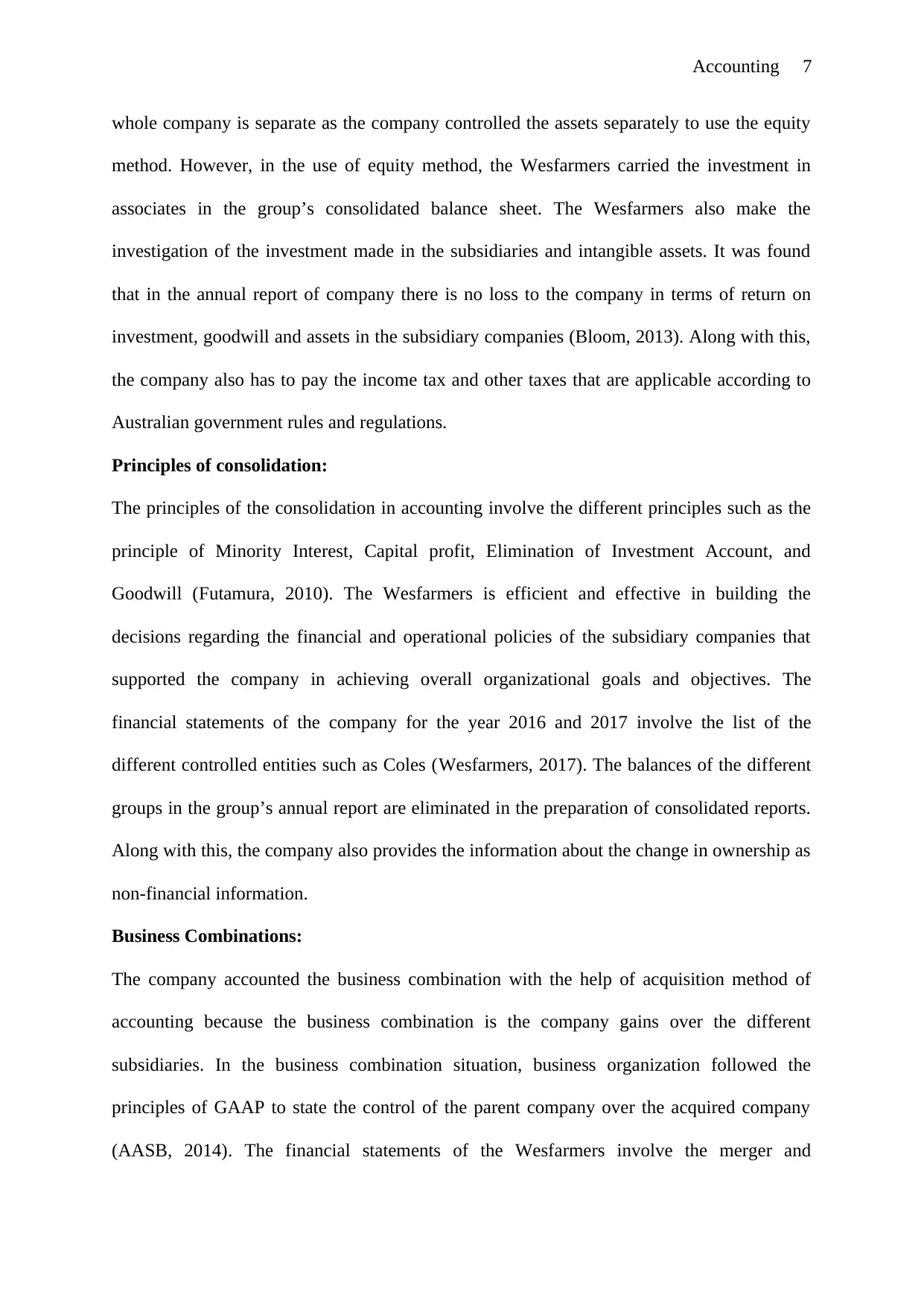
Accounting 7
whole company is separate as the company controlled the assets separately to use the equity
method. However, in the use of equity method, the Wesfarmers carried the investment in
associates in the group’s consolidated balance sheet. The Wesfarmers also make the
investigation of the investment made in the subsidiaries and intangible assets. It was found
that in the annual report of company there is no loss to the company in terms of return on
investment, goodwill and assets in the subsidiary companies (Bloom, 2013). Along with this,
the company also has to pay the income tax and other taxes that are applicable according to
Australian government rules and regulations.
Principles of consolidation:
The principles of the consolidation in accounting involve the different principles such as the
principle of Minority Interest, Capital profit, Elimination of Investment Account, and
Goodwill (Futamura, 2010). The Wesfarmers is efficient and effective in building the
decisions regarding the financial and operational policies of the subsidiary companies that
supported the company in achieving overall organizational goals and objectives. The
financial statements of the company for the year 2016 and 2017 involve the list of the
different controlled entities such as Coles (Wesfarmers, 2017). The balances of the different
groups in the group’s annual report are eliminated in the preparation of consolidated reports.
Along with this, the company also provides the information about the change in ownership as
non-financial information.
Business Combinations:
The company accounted the business combination with the help of acquisition method of
accounting because the business combination is the company gains over the different
subsidiaries. In the business combination situation, business organization followed the
principles of GAAP to state the control of the parent company over the acquired company
(AASB, 2014). The financial statements of the Wesfarmers involve the merger and
whole company is separate as the company controlled the assets separately to use the equity
method. However, in the use of equity method, the Wesfarmers carried the investment in
associates in the group’s consolidated balance sheet. The Wesfarmers also make the
investigation of the investment made in the subsidiaries and intangible assets. It was found
that in the annual report of company there is no loss to the company in terms of return on
investment, goodwill and assets in the subsidiary companies (Bloom, 2013). Along with this,
the company also has to pay the income tax and other taxes that are applicable according to
Australian government rules and regulations.
Principles of consolidation:
The principles of the consolidation in accounting involve the different principles such as the
principle of Minority Interest, Capital profit, Elimination of Investment Account, and
Goodwill (Futamura, 2010). The Wesfarmers is efficient and effective in building the
decisions regarding the financial and operational policies of the subsidiary companies that
supported the company in achieving overall organizational goals and objectives. The
financial statements of the company for the year 2016 and 2017 involve the list of the
different controlled entities such as Coles (Wesfarmers, 2017). The balances of the different
groups in the group’s annual report are eliminated in the preparation of consolidated reports.
Along with this, the company also provides the information about the change in ownership as
non-financial information.
Business Combinations:
The company accounted the business combination with the help of acquisition method of
accounting because the business combination is the company gains over the different
subsidiaries. In the business combination situation, business organization followed the
principles of GAAP to state the control of the parent company over the acquired company
(AASB, 2014). The financial statements of the Wesfarmers involve the merger and
Paraphrase This Document
Need a fresh take? Get an instant paraphrase of this document with our AI Paraphraser
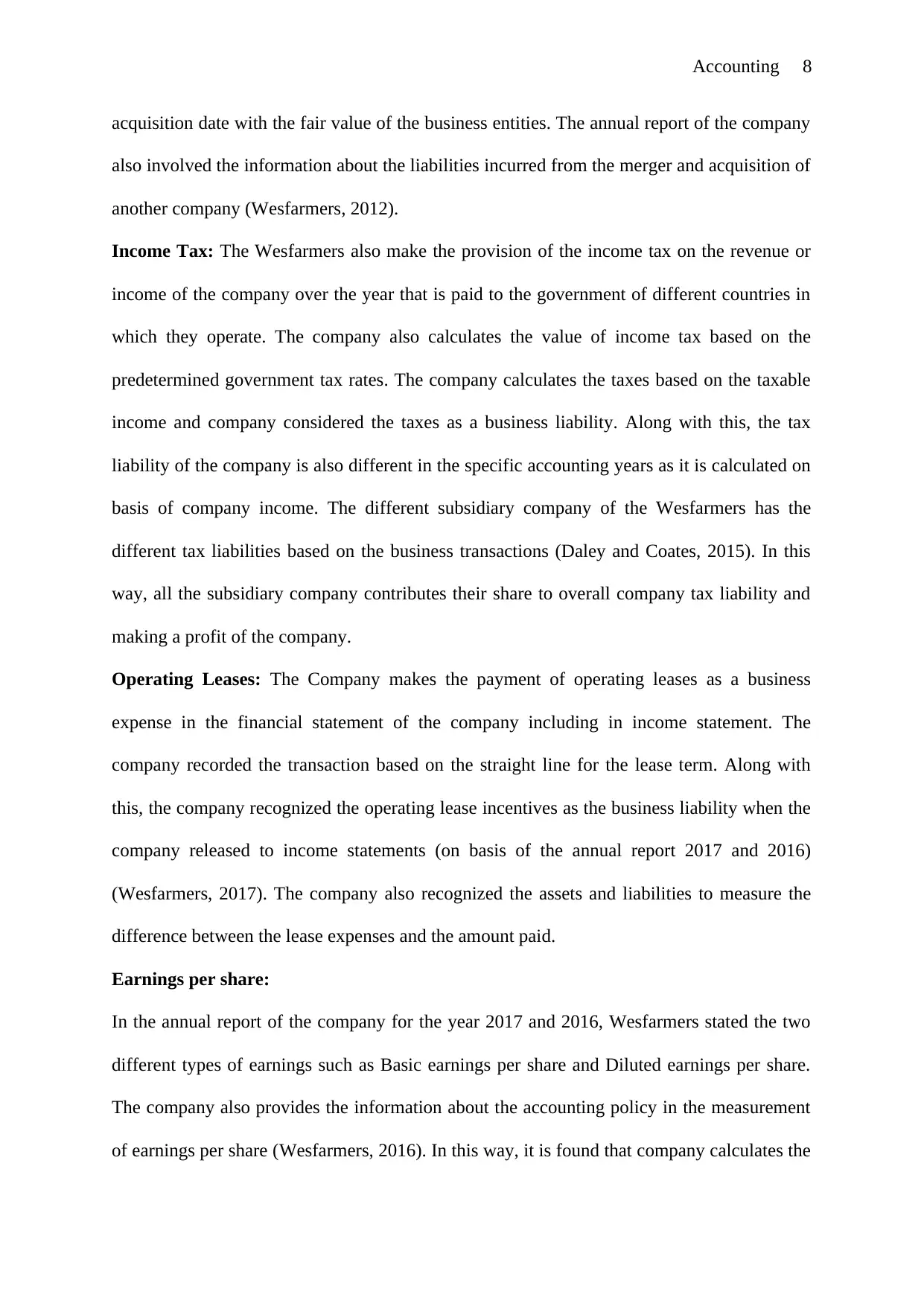
Accounting 8
acquisition date with the fair value of the business entities. The annual report of the company
also involved the information about the liabilities incurred from the merger and acquisition of
another company (Wesfarmers, 2012).
Income Tax: The Wesfarmers also make the provision of the income tax on the revenue or
income of the company over the year that is paid to the government of different countries in
which they operate. The company also calculates the value of income tax based on the
predetermined government tax rates. The company calculates the taxes based on the taxable
income and company considered the taxes as a business liability. Along with this, the tax
liability of the company is also different in the specific accounting years as it is calculated on
basis of company income. The different subsidiary company of the Wesfarmers has the
different tax liabilities based on the business transactions (Daley and Coates, 2015). In this
way, all the subsidiary company contributes their share to overall company tax liability and
making a profit of the company.
Operating Leases: The Company makes the payment of operating leases as a business
expense in the financial statement of the company including in income statement. The
company recorded the transaction based on the straight line for the lease term. Along with
this, the company recognized the operating lease incentives as the business liability when the
company released to income statements (on basis of the annual report 2017 and 2016)
(Wesfarmers, 2017). The company also recognized the assets and liabilities to measure the
difference between the lease expenses and the amount paid.
Earnings per share:
In the annual report of the company for the year 2017 and 2016, Wesfarmers stated the two
different types of earnings such as Basic earnings per share and Diluted earnings per share.
The company also provides the information about the accounting policy in the measurement
of earnings per share (Wesfarmers, 2016). In this way, it is found that company calculates the
acquisition date with the fair value of the business entities. The annual report of the company
also involved the information about the liabilities incurred from the merger and acquisition of
another company (Wesfarmers, 2012).
Income Tax: The Wesfarmers also make the provision of the income tax on the revenue or
income of the company over the year that is paid to the government of different countries in
which they operate. The company also calculates the value of income tax based on the
predetermined government tax rates. The company calculates the taxes based on the taxable
income and company considered the taxes as a business liability. Along with this, the tax
liability of the company is also different in the specific accounting years as it is calculated on
basis of company income. The different subsidiary company of the Wesfarmers has the
different tax liabilities based on the business transactions (Daley and Coates, 2015). In this
way, all the subsidiary company contributes their share to overall company tax liability and
making a profit of the company.
Operating Leases: The Company makes the payment of operating leases as a business
expense in the financial statement of the company including in income statement. The
company recorded the transaction based on the straight line for the lease term. Along with
this, the company recognized the operating lease incentives as the business liability when the
company released to income statements (on basis of the annual report 2017 and 2016)
(Wesfarmers, 2017). The company also recognized the assets and liabilities to measure the
difference between the lease expenses and the amount paid.
Earnings per share:
In the annual report of the company for the year 2017 and 2016, Wesfarmers stated the two
different types of earnings such as Basic earnings per share and Diluted earnings per share.
The company also provides the information about the accounting policy in the measurement
of earnings per share (Wesfarmers, 2016). In this way, it is found that company calculates the

Accounting 9
basic earnings per share through dividing the net profit attributable to all the company
shareholders through a weighted average number of the Wesfarmers ordinary shares.
Whereas company calculated the diluted earnings per share based on the basic earnings per
share and it involves the effects of the interest and dividend that is related to dilutive potential
ordinary shares.
Employee benefits:
The company in its financial statement also makes the company provision of the employees
benefit for all the years including the year 2016 and 2017. It is the accounting and estimates
policy of the Wesfarmers that company measures the employee benefits provision through
using the discount rates that selected from the HQCB (High-Quality Corporate Bond)
(Wesfarmers, 2016). Along with this, the company also represents the employees benefit
from the specific accounting year and provision in the financial statements represents the
incentives accrued and annual leave by the company employees (Daft and Samson, 2014).
The company also included the annual leaves, wages, overtime, salaries, paid and sick leaves
employees benefit in the company policies.
Property, plant, and equipment:
The company has depreciated its assets including the equipment, property, and plants over
every financial year. The Wesfarmers have used the straight-line method for the depreciation
over their useful lives. The land of the company is not depreciated but the building, plant, and
equipment are depreciated. Therefore, company estimate that life of the building is around 20
to 40 years and plant and equipment is around 3 to 40 years as per the annual report 2017
(Wesfarmers, 2017).
Section 2: Assess Accounting Flexibility
Accounting flexibility is required in every organization in the modern time. This is the
adaptation capability of the organization to change in its accounting system as per the needs,
basic earnings per share through dividing the net profit attributable to all the company
shareholders through a weighted average number of the Wesfarmers ordinary shares.
Whereas company calculated the diluted earnings per share based on the basic earnings per
share and it involves the effects of the interest and dividend that is related to dilutive potential
ordinary shares.
Employee benefits:
The company in its financial statement also makes the company provision of the employees
benefit for all the years including the year 2016 and 2017. It is the accounting and estimates
policy of the Wesfarmers that company measures the employee benefits provision through
using the discount rates that selected from the HQCB (High-Quality Corporate Bond)
(Wesfarmers, 2016). Along with this, the company also represents the employees benefit
from the specific accounting year and provision in the financial statements represents the
incentives accrued and annual leave by the company employees (Daft and Samson, 2014).
The company also included the annual leaves, wages, overtime, salaries, paid and sick leaves
employees benefit in the company policies.
Property, plant, and equipment:
The company has depreciated its assets including the equipment, property, and plants over
every financial year. The Wesfarmers have used the straight-line method for the depreciation
over their useful lives. The land of the company is not depreciated but the building, plant, and
equipment are depreciated. Therefore, company estimate that life of the building is around 20
to 40 years and plant and equipment is around 3 to 40 years as per the annual report 2017
(Wesfarmers, 2017).
Section 2: Assess Accounting Flexibility
Accounting flexibility is required in every organization in the modern time. This is the
adaptation capability of the organization to change in its accounting system as per the needs,

Accounting 10
and operation. Companies have to undergo the changes due to changes in external
environment, which can cause changes in the accounting system and procedure of
organizations (Olad and Amiri, 2016). The flexible accounting system makes the
organization able to track the financial growth. The flexible accounting procedure makes the
firm able to accommodate the unexpected and contingent transactions to determine the
accuracy of accounting and reporting (Denis and McKeon, 2016). The organizations with the
highly flexible accounting system are highly adaptive to the changes in the external and
internal environment.
The flexibility of accounting allows the accommodation of unexpected and unplanned
changes in the financial values of the organization. There are different accounting/financial
components that are globally taken as the flexible items such as financial leverage including
debt, liquidity, and others. Apart from this, cash holdings such as money in the bank,
overdraft, and others are also included in the flexible accounting policies (Koch et al., 2012).
Wesfarmers Limited, which is an international retail chain, uses flexible accounting system to
record the transactions and report the financial information to its stakeholders. The company
prepares a budget using the flexible budgeting system based on the previous budget. The
flexible budget helps Wesfarmers in detecting the deviation from the last budget and
determining the budget for current or next year accordingly. The flexible budget can also help
in reducing the gap between actual values and budgeted values for the organization. Apart
from this, the Wesfarmers operates in different countries, where it accepts the provision of
local accounting and reporting standards of the respective countries (Wesfarmers, 2016). This
indicates that how flexible accounting system the Wesfarmers uses. Woolworths is the
biggest competitor of the Wesfarmers, which also do use the flexible accounting system.
Woolworths also adapt to the local accounting standards to the different economies. The
flexible accounting system helps both the organization to accommodate the changes in the
and operation. Companies have to undergo the changes due to changes in external
environment, which can cause changes in the accounting system and procedure of
organizations (Olad and Amiri, 2016). The flexible accounting system makes the
organization able to track the financial growth. The flexible accounting procedure makes the
firm able to accommodate the unexpected and contingent transactions to determine the
accuracy of accounting and reporting (Denis and McKeon, 2016). The organizations with the
highly flexible accounting system are highly adaptive to the changes in the external and
internal environment.
The flexibility of accounting allows the accommodation of unexpected and unplanned
changes in the financial values of the organization. There are different accounting/financial
components that are globally taken as the flexible items such as financial leverage including
debt, liquidity, and others. Apart from this, cash holdings such as money in the bank,
overdraft, and others are also included in the flexible accounting policies (Koch et al., 2012).
Wesfarmers Limited, which is an international retail chain, uses flexible accounting system to
record the transactions and report the financial information to its stakeholders. The company
prepares a budget using the flexible budgeting system based on the previous budget. The
flexible budget helps Wesfarmers in detecting the deviation from the last budget and
determining the budget for current or next year accordingly. The flexible budget can also help
in reducing the gap between actual values and budgeted values for the organization. Apart
from this, the Wesfarmers operates in different countries, where it accepts the provision of
local accounting and reporting standards of the respective countries (Wesfarmers, 2016). This
indicates that how flexible accounting system the Wesfarmers uses. Woolworths is the
biggest competitor of the Wesfarmers, which also do use the flexible accounting system.
Woolworths also adapt to the local accounting standards to the different economies. The
flexible accounting system helps both the organization to accommodate the changes in the
Secure Best Marks with AI Grader
Need help grading? Try our AI Grader for instant feedback on your assignments.

Accounting 11
values as per the market situation to assure the accuracy and updated information
(Wesfarmers, 2017). The companies include the value of the previous year and current year
in the balance sheet, income statement and cash flow statement so that the deviation between
two years can be identified.
Section 3: Evaluate Accounting Strategy
Accounting is an important and compulsory activity that must have to be done in the all the
organizations throughout the world. The accounting can be defined as the process in which
the information is collected, recorded, classified, summarized and interpreted to make it
useful and meaningful. The accounting and financial information are required to make an
effective financial decision in the organization (Hoyle et al., 2015). Accounting and financial
reports of the organization are considered to be the best and authorized source of information
for the investment and financial decisions. The organizations mostly prepare the strategies
based on the historical data. The companies summarize the financial information in financial
statement retrieved from the notes of the financial statements. This strategy helps in getting
the insight that how the specific value in the statements is derived from and how they have
been computed (Bonin, 2013). The historical information helps in comparing the
performance of the company with current year performance so that effective decision can be
taken to improve the performance.
Wesfarmers Limited is one of the largest global players in the market. It uses consistent
accounting policies. The company uses consolidated financial statements which include the
financial information of the all the units of the organization. Along with this, it includes the
employees' benefit expenses, remuneration, and taxation and other information. It uses hedge
accounting policy for managing the risk. Apart from this, the acquisition accounting is used
by the organization for tax consideration and ongoing work valuation (Wesfarmers, 2016).
The company uses tax consolidation policy in which it tax liability of the subsidiaries of the
values as per the market situation to assure the accuracy and updated information
(Wesfarmers, 2017). The companies include the value of the previous year and current year
in the balance sheet, income statement and cash flow statement so that the deviation between
two years can be identified.
Section 3: Evaluate Accounting Strategy
Accounting is an important and compulsory activity that must have to be done in the all the
organizations throughout the world. The accounting can be defined as the process in which
the information is collected, recorded, classified, summarized and interpreted to make it
useful and meaningful. The accounting and financial information are required to make an
effective financial decision in the organization (Hoyle et al., 2015). Accounting and financial
reports of the organization are considered to be the best and authorized source of information
for the investment and financial decisions. The organizations mostly prepare the strategies
based on the historical data. The companies summarize the financial information in financial
statement retrieved from the notes of the financial statements. This strategy helps in getting
the insight that how the specific value in the statements is derived from and how they have
been computed (Bonin, 2013). The historical information helps in comparing the
performance of the company with current year performance so that effective decision can be
taken to improve the performance.
Wesfarmers Limited is one of the largest global players in the market. It uses consistent
accounting policies. The company uses consolidated financial statements which include the
financial information of the all the units of the organization. Along with this, it includes the
employees' benefit expenses, remuneration, and taxation and other information. It uses hedge
accounting policy for managing the risk. Apart from this, the acquisition accounting is used
by the organization for tax consideration and ongoing work valuation (Wesfarmers, 2016).
The company uses tax consolidation policy in which it tax liability of the subsidiaries of the
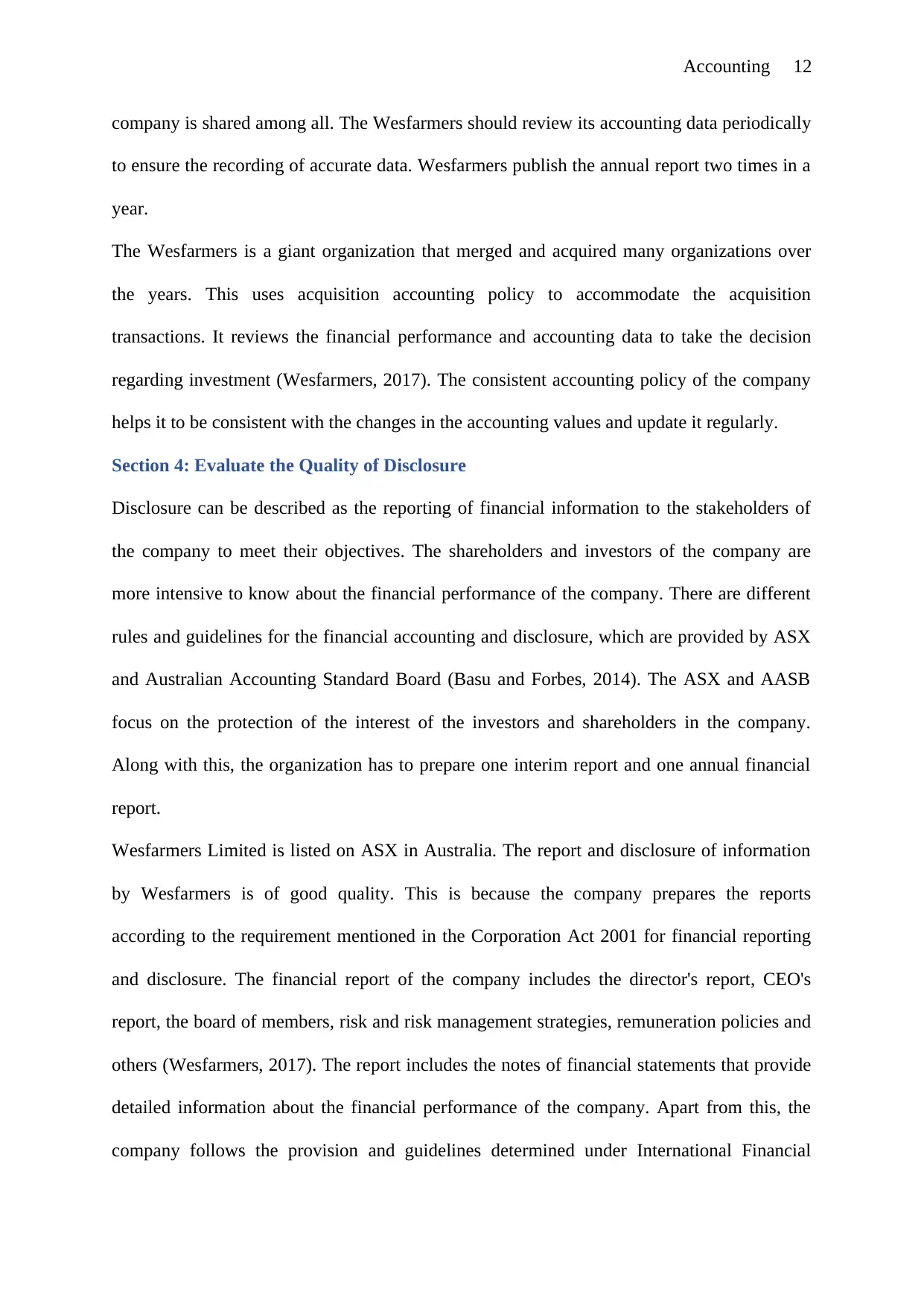
Accounting 12
company is shared among all. The Wesfarmers should review its accounting data periodically
to ensure the recording of accurate data. Wesfarmers publish the annual report two times in a
year.
The Wesfarmers is a giant organization that merged and acquired many organizations over
the years. This uses acquisition accounting policy to accommodate the acquisition
transactions. It reviews the financial performance and accounting data to take the decision
regarding investment (Wesfarmers, 2017). The consistent accounting policy of the company
helps it to be consistent with the changes in the accounting values and update it regularly.
Section 4: Evaluate the Quality of Disclosure
Disclosure can be described as the reporting of financial information to the stakeholders of
the company to meet their objectives. The shareholders and investors of the company are
more intensive to know about the financial performance of the company. There are different
rules and guidelines for the financial accounting and disclosure, which are provided by ASX
and Australian Accounting Standard Board (Basu and Forbes, 2014). The ASX and AASB
focus on the protection of the interest of the investors and shareholders in the company.
Along with this, the organization has to prepare one interim report and one annual financial
report.
Wesfarmers Limited is listed on ASX in Australia. The report and disclosure of information
by Wesfarmers is of good quality. This is because the company prepares the reports
according to the requirement mentioned in the Corporation Act 2001 for financial reporting
and disclosure. The financial report of the company includes the director's report, CEO's
report, the board of members, risk and risk management strategies, remuneration policies and
others (Wesfarmers, 2017). The report includes the notes of financial statements that provide
detailed information about the financial performance of the company. Apart from this, the
company follows the provision and guidelines determined under International Financial
company is shared among all. The Wesfarmers should review its accounting data periodically
to ensure the recording of accurate data. Wesfarmers publish the annual report two times in a
year.
The Wesfarmers is a giant organization that merged and acquired many organizations over
the years. This uses acquisition accounting policy to accommodate the acquisition
transactions. It reviews the financial performance and accounting data to take the decision
regarding investment (Wesfarmers, 2017). The consistent accounting policy of the company
helps it to be consistent with the changes in the accounting values and update it regularly.
Section 4: Evaluate the Quality of Disclosure
Disclosure can be described as the reporting of financial information to the stakeholders of
the company to meet their objectives. The shareholders and investors of the company are
more intensive to know about the financial performance of the company. There are different
rules and guidelines for the financial accounting and disclosure, which are provided by ASX
and Australian Accounting Standard Board (Basu and Forbes, 2014). The ASX and AASB
focus on the protection of the interest of the investors and shareholders in the company.
Along with this, the organization has to prepare one interim report and one annual financial
report.
Wesfarmers Limited is listed on ASX in Australia. The report and disclosure of information
by Wesfarmers is of good quality. This is because the company prepares the reports
according to the requirement mentioned in the Corporation Act 2001 for financial reporting
and disclosure. The financial report of the company includes the director's report, CEO's
report, the board of members, risk and risk management strategies, remuneration policies and
others (Wesfarmers, 2017). The report includes the notes of financial statements that provide
detailed information about the financial performance of the company. Apart from this, the
company follows the provision and guidelines determined under International Financial
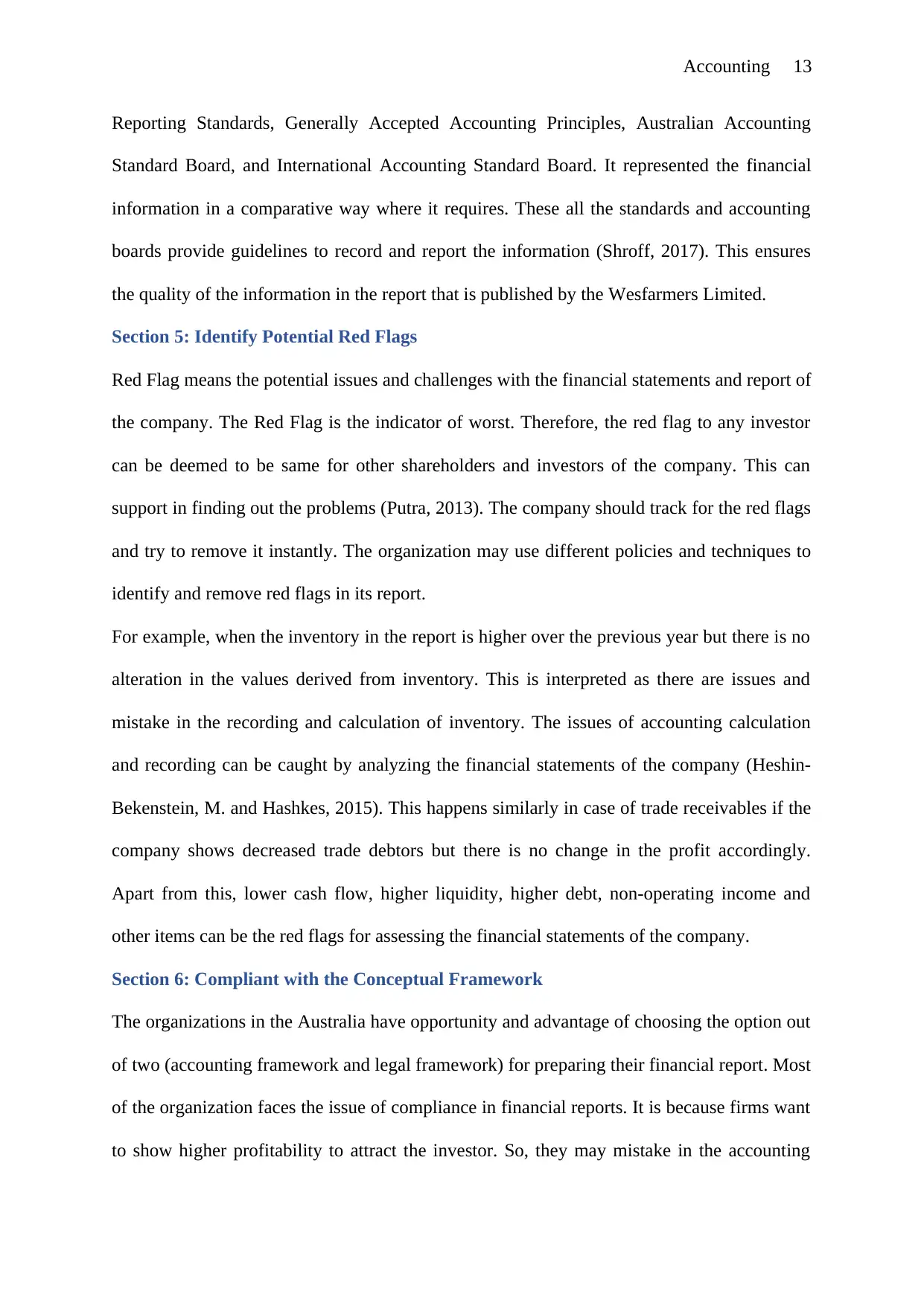
Accounting 13
Reporting Standards, Generally Accepted Accounting Principles, Australian Accounting
Standard Board, and International Accounting Standard Board. It represented the financial
information in a comparative way where it requires. These all the standards and accounting
boards provide guidelines to record and report the information (Shroff, 2017). This ensures
the quality of the information in the report that is published by the Wesfarmers Limited.
Section 5: Identify Potential Red Flags
Red Flag means the potential issues and challenges with the financial statements and report of
the company. The Red Flag is the indicator of worst. Therefore, the red flag to any investor
can be deemed to be same for other shareholders and investors of the company. This can
support in finding out the problems (Putra, 2013). The company should track for the red flags
and try to remove it instantly. The organization may use different policies and techniques to
identify and remove red flags in its report.
For example, when the inventory in the report is higher over the previous year but there is no
alteration in the values derived from inventory. This is interpreted as there are issues and
mistake in the recording and calculation of inventory. The issues of accounting calculation
and recording can be caught by analyzing the financial statements of the company (Heshin-
Bekenstein, M. and Hashkes, 2015). This happens similarly in case of trade receivables if the
company shows decreased trade debtors but there is no change in the profit accordingly.
Apart from this, lower cash flow, higher liquidity, higher debt, non-operating income and
other items can be the red flags for assessing the financial statements of the company.
Section 6: Compliant with the Conceptual Framework
The organizations in the Australia have opportunity and advantage of choosing the option out
of two (accounting framework and legal framework) for preparing their financial report. Most
of the organization faces the issue of compliance in financial reports. It is because firms want
to show higher profitability to attract the investor. So, they may mistake in the accounting
Reporting Standards, Generally Accepted Accounting Principles, Australian Accounting
Standard Board, and International Accounting Standard Board. It represented the financial
information in a comparative way where it requires. These all the standards and accounting
boards provide guidelines to record and report the information (Shroff, 2017). This ensures
the quality of the information in the report that is published by the Wesfarmers Limited.
Section 5: Identify Potential Red Flags
Red Flag means the potential issues and challenges with the financial statements and report of
the company. The Red Flag is the indicator of worst. Therefore, the red flag to any investor
can be deemed to be same for other shareholders and investors of the company. This can
support in finding out the problems (Putra, 2013). The company should track for the red flags
and try to remove it instantly. The organization may use different policies and techniques to
identify and remove red flags in its report.
For example, when the inventory in the report is higher over the previous year but there is no
alteration in the values derived from inventory. This is interpreted as there are issues and
mistake in the recording and calculation of inventory. The issues of accounting calculation
and recording can be caught by analyzing the financial statements of the company (Heshin-
Bekenstein, M. and Hashkes, 2015). This happens similarly in case of trade receivables if the
company shows decreased trade debtors but there is no change in the profit accordingly.
Apart from this, lower cash flow, higher liquidity, higher debt, non-operating income and
other items can be the red flags for assessing the financial statements of the company.
Section 6: Compliant with the Conceptual Framework
The organizations in the Australia have opportunity and advantage of choosing the option out
of two (accounting framework and legal framework) for preparing their financial report. Most
of the organization faces the issue of compliance in financial reports. It is because firms want
to show higher profitability to attract the investor. So, they may mistake in the accounting
Paraphrase This Document
Need a fresh take? Get an instant paraphrase of this document with our AI Paraphraser

Accounting 14
and reporting to attract a large number of investors (Oluku and Ojeka, 2011). The large
organizations generally do this. Companies listed on Australian Security Exchange has to
prepare the simple annual report that the auditors can easily audit and make avail for
everyone. ASX requires the organizations to provide periodic financial highlights and interim
financial reports. The Wesfarmers follows the guidelines and rules of ASX for preparing its
report and disclosing the information. It discloses the financial and non-financial information
in its report that meets the IFRS, GAAP, and Australian Accounting Standards (Wesfarmers,
2016).
and reporting to attract a large number of investors (Oluku and Ojeka, 2011). The large
organizations generally do this. Companies listed on Australian Security Exchange has to
prepare the simple annual report that the auditors can easily audit and make avail for
everyone. ASX requires the organizations to provide periodic financial highlights and interim
financial reports. The Wesfarmers follows the guidelines and rules of ASX for preparing its
report and disclosing the information. It discloses the financial and non-financial information
in its report that meets the IFRS, GAAP, and Australian Accounting Standards (Wesfarmers,
2016).
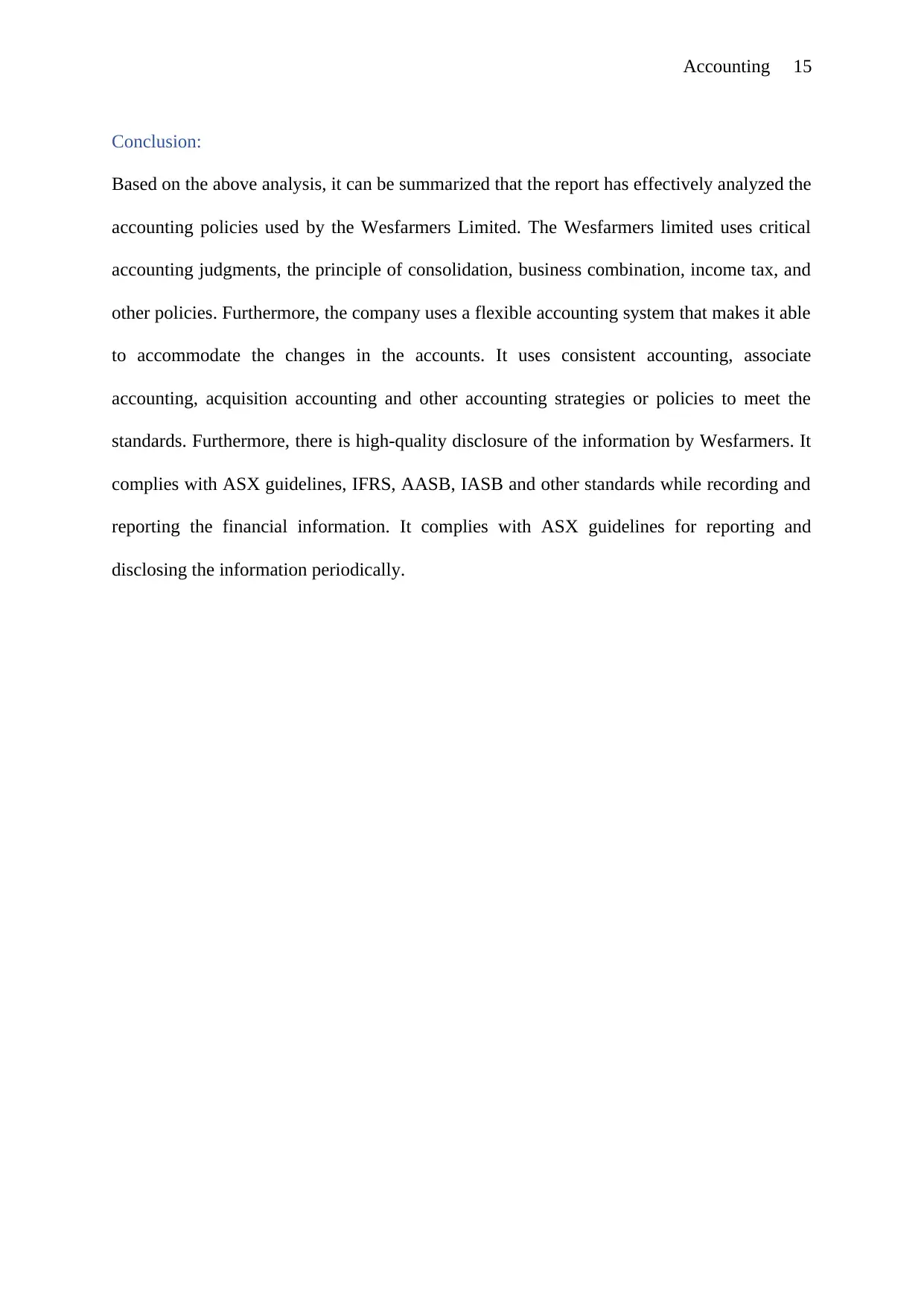
Accounting 15
Conclusion:
Based on the above analysis, it can be summarized that the report has effectively analyzed the
accounting policies used by the Wesfarmers Limited. The Wesfarmers limited uses critical
accounting judgments, the principle of consolidation, business combination, income tax, and
other policies. Furthermore, the company uses a flexible accounting system that makes it able
to accommodate the changes in the accounts. It uses consistent accounting, associate
accounting, acquisition accounting and other accounting strategies or policies to meet the
standards. Furthermore, there is high-quality disclosure of the information by Wesfarmers. It
complies with ASX guidelines, IFRS, AASB, IASB and other standards while recording and
reporting the financial information. It complies with ASX guidelines for reporting and
disclosing the information periodically.
Conclusion:
Based on the above analysis, it can be summarized that the report has effectively analyzed the
accounting policies used by the Wesfarmers Limited. The Wesfarmers limited uses critical
accounting judgments, the principle of consolidation, business combination, income tax, and
other policies. Furthermore, the company uses a flexible accounting system that makes it able
to accommodate the changes in the accounts. It uses consistent accounting, associate
accounting, acquisition accounting and other accounting strategies or policies to meet the
standards. Furthermore, there is high-quality disclosure of the information by Wesfarmers. It
complies with ASX guidelines, IFRS, AASB, IASB and other standards while recording and
reporting the financial information. It complies with ASX guidelines for reporting and
disclosing the information periodically.

Accounting 16
References:
AASB, C. A. S. (2014). Business Combinations. Disclosure, 66, 77.
Basu, A.K. and Forbes, B. (2014). Does fundamental indexation lead to better risk‐adjusted
returns? New evidence from Australian Securities Exchange, Accounting & Finance, 54(3),
699-728.
Bloom, M., (2013). Double accounting for goodwill: A problem redefined. UK: Routledge.
Bonin, H. (2013). Generational accounting: theory and application. Germany: Springer
Science & Business Media
Cheung, E., Evans, E., & Wright, S. (2010). An historical review of quality in financial
reporting in Australia. Pacific Accounting Review, 22(2), 147-169.
Daft, R. and Samson, D. (2014) Fundamentals of Management. AU: Cengage Learning.
Daley, J., & Coates, B. (2015). Property taxes. AU: Grattan Institute.
Denis, D.J. and McKeon, S.B. (2016). Proactive Leverage Increases and The Value of
Financial Flexibility, Journal of Applied Corporate Finance, 28(4), 17-28.
Futamura, M. (2010). The introduction of accounting principles for consolidated financial
statements in Japan: focus on minority interest and other related accounting
treatments. Journal of International Business Research, 9, 1.
Heshin-Bekenstein, M. and Hashkes, P. J. (2015). Intestinal malrotation as a misdiagnosis of
pediatric colchicine resistant familial Mediterranean fever, Pediatric Rheumatology, 13(1),45.
Hoyle, J.B., Schaefer, T. and Doupnik, T. (2015). Advanced accounting. USA: McGraw Hill.
Koch, A.S., Lefanowicz, C.E. and Shane, P.B. (2012). Earnings Guidance and Earnings
Management Constraints.
Olad, Z. S. and Amiri, H. (2016). The effect of cost Accounting change on the performance
of Manufacturing Companies in Khuzestan, Bull. Env. Pharmacol. Life Sci. (1) 78-91.
References:
AASB, C. A. S. (2014). Business Combinations. Disclosure, 66, 77.
Basu, A.K. and Forbes, B. (2014). Does fundamental indexation lead to better risk‐adjusted
returns? New evidence from Australian Securities Exchange, Accounting & Finance, 54(3),
699-728.
Bloom, M., (2013). Double accounting for goodwill: A problem redefined. UK: Routledge.
Bonin, H. (2013). Generational accounting: theory and application. Germany: Springer
Science & Business Media
Cheung, E., Evans, E., & Wright, S. (2010). An historical review of quality in financial
reporting in Australia. Pacific Accounting Review, 22(2), 147-169.
Daft, R. and Samson, D. (2014) Fundamentals of Management. AU: Cengage Learning.
Daley, J., & Coates, B. (2015). Property taxes. AU: Grattan Institute.
Denis, D.J. and McKeon, S.B. (2016). Proactive Leverage Increases and The Value of
Financial Flexibility, Journal of Applied Corporate Finance, 28(4), 17-28.
Futamura, M. (2010). The introduction of accounting principles for consolidated financial
statements in Japan: focus on minority interest and other related accounting
treatments. Journal of International Business Research, 9, 1.
Heshin-Bekenstein, M. and Hashkes, P. J. (2015). Intestinal malrotation as a misdiagnosis of
pediatric colchicine resistant familial Mediterranean fever, Pediatric Rheumatology, 13(1),45.
Hoyle, J.B., Schaefer, T. and Doupnik, T. (2015). Advanced accounting. USA: McGraw Hill.
Koch, A.S., Lefanowicz, C.E. and Shane, P.B. (2012). Earnings Guidance and Earnings
Management Constraints.
Olad, Z. S. and Amiri, H. (2016). The effect of cost Accounting change on the performance
of Manufacturing Companies in Khuzestan, Bull. Env. Pharmacol. Life Sci. (1) 78-91.
Secure Best Marks with AI Grader
Need help grading? Try our AI Grader for instant feedback on your assignments.
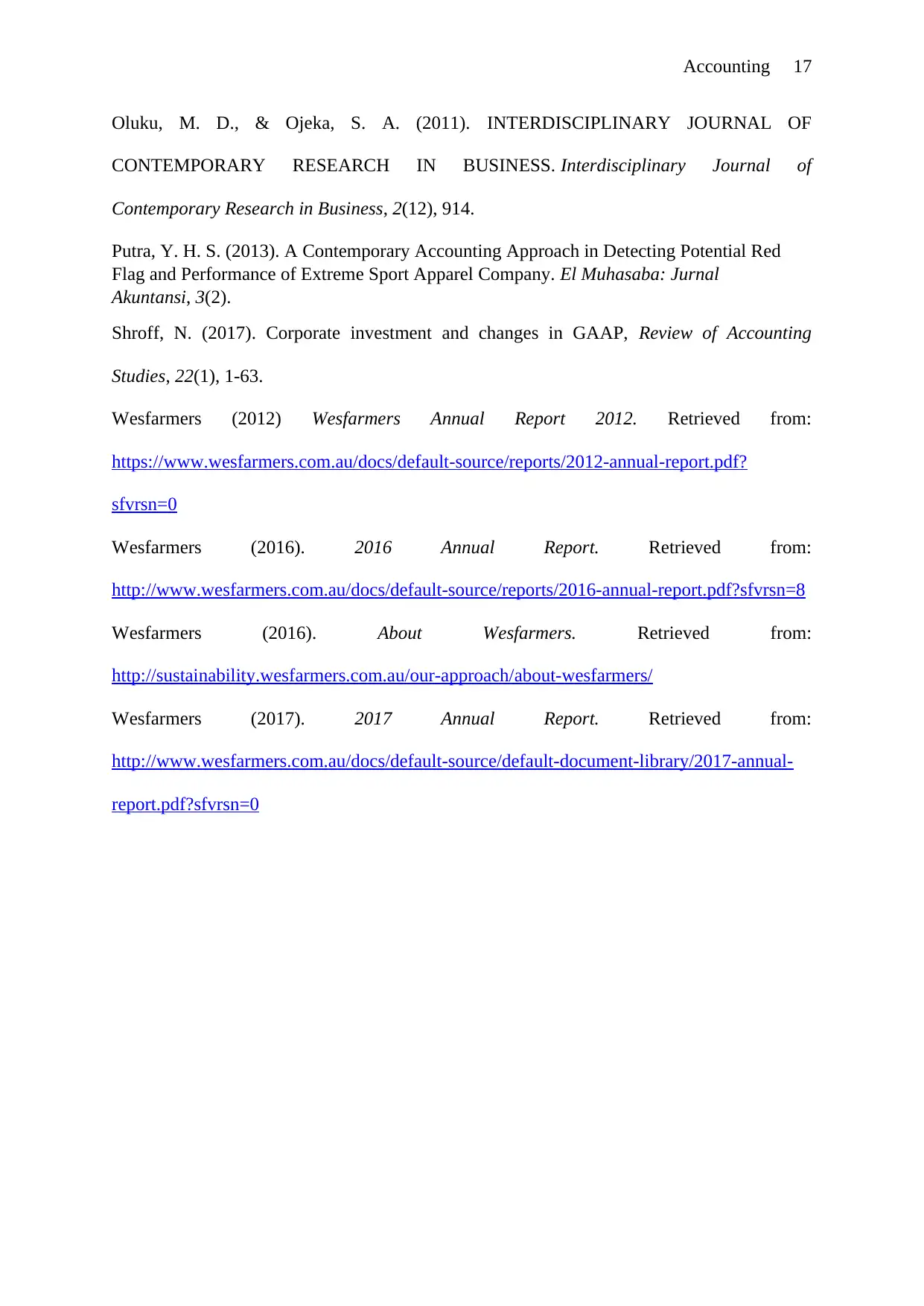
Accounting 17
Oluku, M. D., & Ojeka, S. A. (2011). INTERDISCIPLINARY JOURNAL OF
CONTEMPORARY RESEARCH IN BUSINESS. Interdisciplinary Journal of
Contemporary Research in Business, 2(12), 914.
Putra, Y. H. S. (2013). A Contemporary Accounting Approach in Detecting Potential Red
Flag and Performance of Extreme Sport Apparel Company. El Muhasaba: Jurnal
Akuntansi, 3(2).
Shroff, N. (2017). Corporate investment and changes in GAAP, Review of Accounting
Studies, 22(1), 1-63.
Wesfarmers (2012) Wesfarmers Annual Report 2012. Retrieved from:
https://www.wesfarmers.com.au/docs/default-source/reports/2012-annual-report.pdf?
sfvrsn=0
Wesfarmers (2016). 2016 Annual Report. Retrieved from:
http://www.wesfarmers.com.au/docs/default-source/reports/2016-annual-report.pdf?sfvrsn=8
Wesfarmers (2016). About Wesfarmers. Retrieved from:
http://sustainability.wesfarmers.com.au/our-approach/about-wesfarmers/
Wesfarmers (2017). 2017 Annual Report. Retrieved from:
http://www.wesfarmers.com.au/docs/default-source/default-document-library/2017-annual-
report.pdf?sfvrsn=0
Oluku, M. D., & Ojeka, S. A. (2011). INTERDISCIPLINARY JOURNAL OF
CONTEMPORARY RESEARCH IN BUSINESS. Interdisciplinary Journal of
Contemporary Research in Business, 2(12), 914.
Putra, Y. H. S. (2013). A Contemporary Accounting Approach in Detecting Potential Red
Flag and Performance of Extreme Sport Apparel Company. El Muhasaba: Jurnal
Akuntansi, 3(2).
Shroff, N. (2017). Corporate investment and changes in GAAP, Review of Accounting
Studies, 22(1), 1-63.
Wesfarmers (2012) Wesfarmers Annual Report 2012. Retrieved from:
https://www.wesfarmers.com.au/docs/default-source/reports/2012-annual-report.pdf?
sfvrsn=0
Wesfarmers (2016). 2016 Annual Report. Retrieved from:
http://www.wesfarmers.com.au/docs/default-source/reports/2016-annual-report.pdf?sfvrsn=8
Wesfarmers (2016). About Wesfarmers. Retrieved from:
http://sustainability.wesfarmers.com.au/our-approach/about-wesfarmers/
Wesfarmers (2017). 2017 Annual Report. Retrieved from:
http://www.wesfarmers.com.au/docs/default-source/default-document-library/2017-annual-
report.pdf?sfvrsn=0
1 out of 17
Related Documents
Your All-in-One AI-Powered Toolkit for Academic Success.
+13062052269
info@desklib.com
Available 24*7 on WhatsApp / Email
![[object Object]](/_next/static/media/star-bottom.7253800d.svg)
Unlock your academic potential
© 2024 | Zucol Services PVT LTD | All rights reserved.





